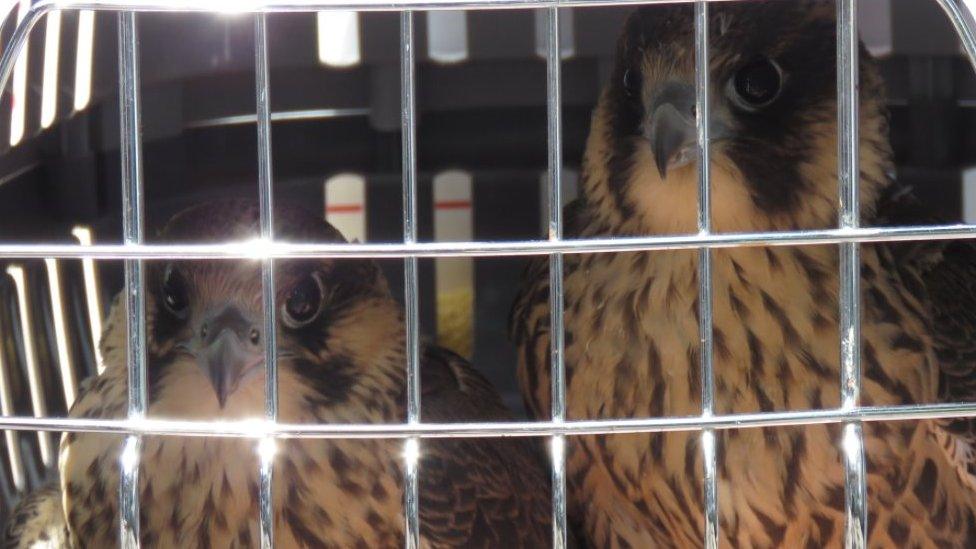The minders with their eyes on the Cambridge peregrines
- Published
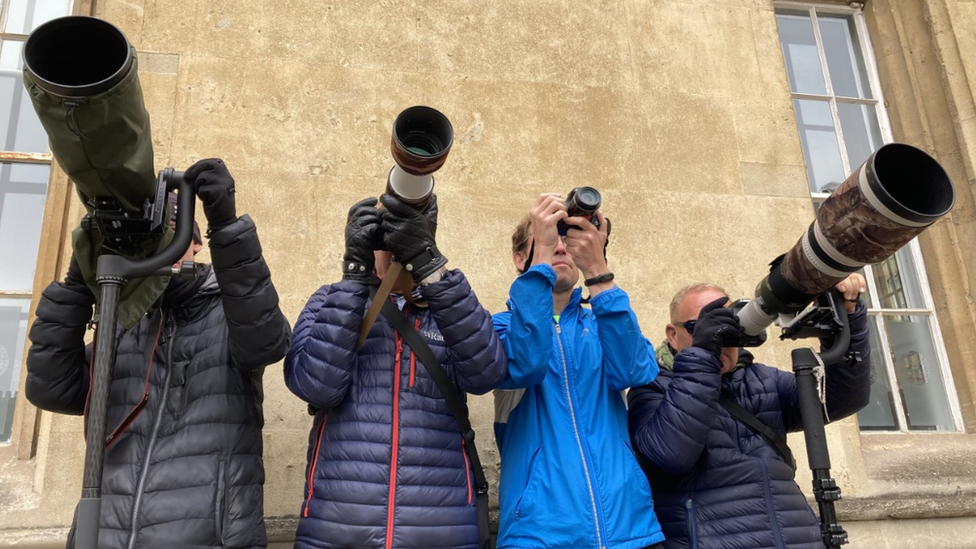
The photographers can be seen every day on Trumpington Street monitoring the young family of falcons
A group of dedicated photographers can be regularly seen on a Cambridge street, their camera lenses trained on the high college roofs around them. Their focus is a young family of peregrine falcons.
It's fledging season in peregrine falcon world.
For the first time in years, four chicks have hatched to two devoted parents on the Cambridge rooftops.
They are oblivious to the enthusiasts below, who monitor every special moment of their domestic lives, from housework and preening, to meal times and bath times.
So why do they do it?
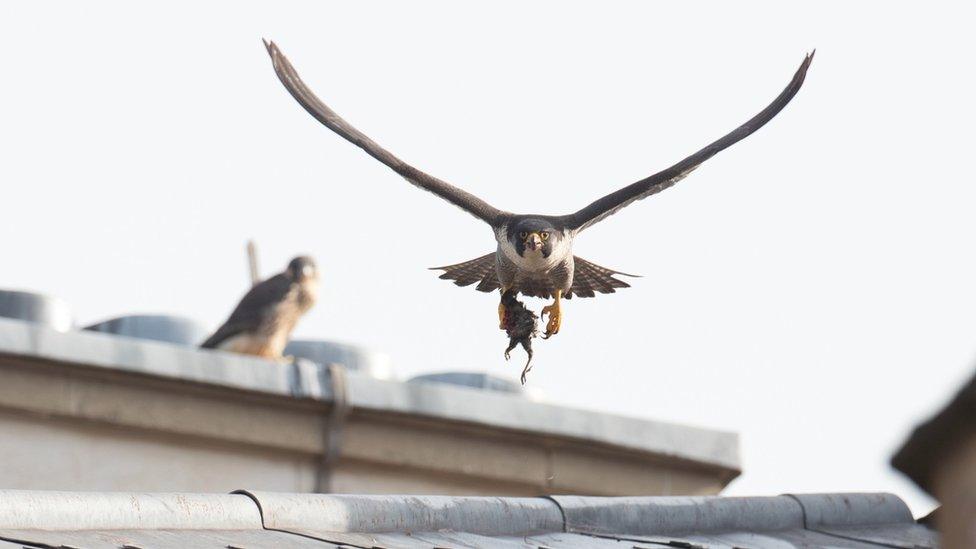
The peregrine falcon parents bring food back to the four chicks that have fledged in Cambridge in recent weeks

'It's addictive'
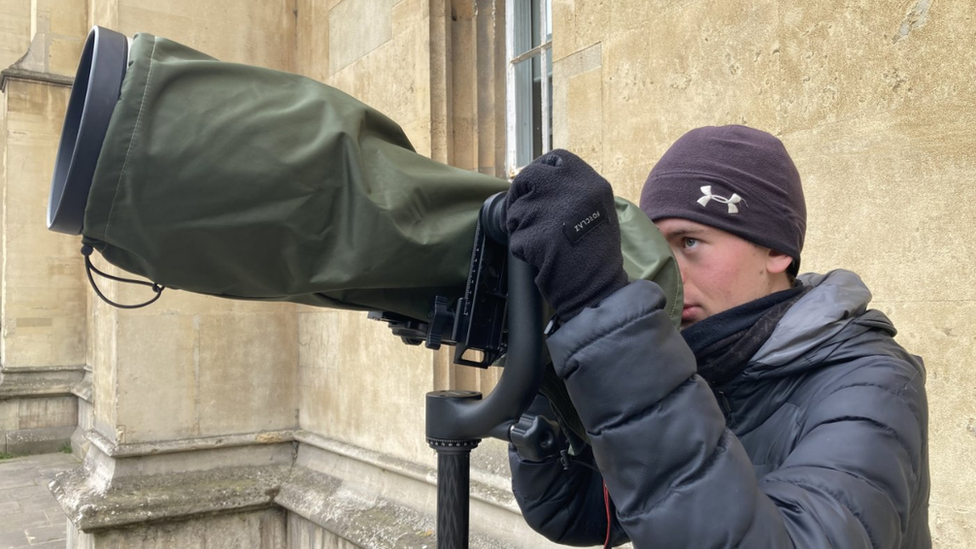
Jamie Clarkson splits his time between wildlife photography and his PHD studies at the University of Cambridge
For the last month, Jamie Clarkson has turned up at a prime viewing spot in Trumpington Street at 05:00 BST, armed with a Canon DSLR and a very, very long lens.
The 24-year-old, from Edinburgh, splits his time between wildlife photography and his PHD studies in structural engineering at Trinity Hall, Cambridge.
In the winter, he photographs barn owls. In the spring and summer - it's all about the peregrine falcons.
"Mornings are the best time because they are most active then, it's nice and quiet so you can focus on the photography - and the light is nice and soft," he says.
"A bit of it is the challenge getting the shot in the frame while they're moving because they are so fast - it's addictive."

The peregrine falcon parents bring food back to the four chicks that have fledged in Cambridge in recent weeks
"I started with a bridge camera but I wanted to get that next level of image quality and get shots in flight with something that could deal with a higher shutter speed and focus a bit faster.
"It's all about seeing the behaviour as it changes through the seasons. We were here in January and February when they began to spend a bit more time at the nest site and mating.
"Then they're laying eggs because you can see the parents change over incubation duty, then they start bringing food into the nest."

Feeding time: A young peregrine falcon peers out from the roof of Pembroke College

'Your heart is pumping'

Darren Benson took up photography when he left school and after training as a footballer
Darren Benson admits observing the peregrines is a far cry from his former life as a tabloid photographer.
The 54-year-old, who moved to Cambridge from East London 30 years ago, said he was "hooked" after first snapping the birds back in 2015.
"I was doing pictures of The Backs [where colleges back onto The River Cam] for a magazine and a friend who owned a camera shop mentioned there was a falcon on top of the church" he says.
"That was it. I've got PTSD. I've covered national events including the Tottenham riots but when I come to do the pictures of the falcons, it's chilled me completely out.
"Seeing a falcon holding a bird and flying into the nest to feed their young, your heart is pumping.
"I want a story - I want to see what the emotion of the bird is. You don't know what's going to happen from day to day."
Mr Benson, who also devotes his time to mental health workshops, uses a Canon D90 with a lengthy 500 lens.
"You can pick up scales on the foot of the bird, the battles she's been through over the years, the age through the lines on her face, the detail on the beak," he says.

'It's about their welfare'
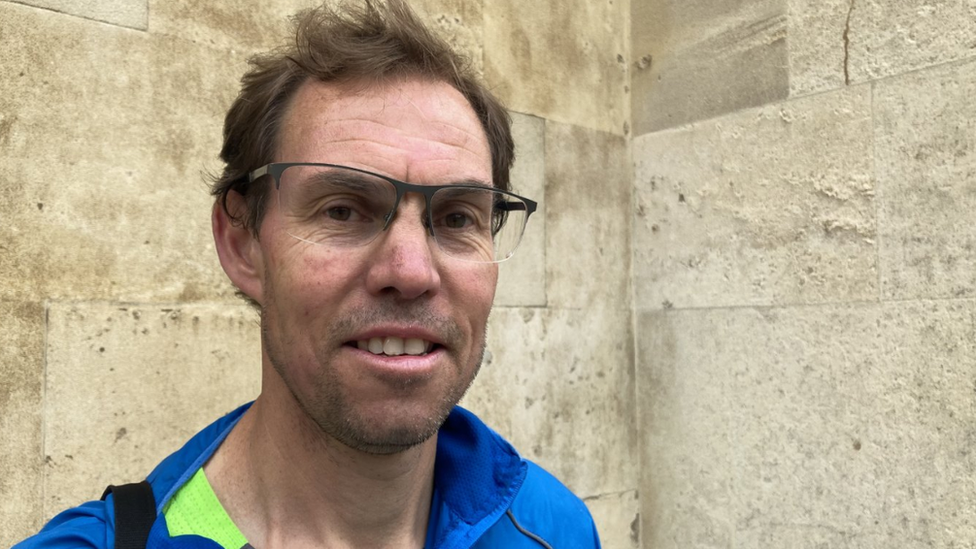
Saimon Clark monitors the behaviour of the peregrine family and curates a dedicated Twitter page
"Some cities have nest boxes but the peregrines here chose this nest site themselves," says Saimon Clark, who updates a Twitter page, external with the family's progress.
He walks from his job at the University of Cambridge language centre several times a day to keep an eye on them.
"The reason I do it is to document what they are doing and I'm interested in their behaviour and what they do throughout the year," he says.
"I'll pick up feathers and try to identify a list of all the things they've eaten. At this time of year it's starlings, pigeons, the occasional jackdaw or blackbirds."
He says he has identified a list of more than 20 different birds they eat.
"Because Cambridge is so small, I can walk between the different locations, see where they are and just take notes of it," he adds.
"The adults are here all year round, they'll perch on the URC [United Reformed Church], the King's College spires, St John's Chapel, the university library, and St Botolph's - the tall points in the sky."
He says four is the biggest number of chicks they've had since they began monitoring the falcons in 2015.
"Peregrines have increased in numbers in last few decades but they're still relatively rare," he says.
"It's about their welfare, making sure that someone is here to look out for them."
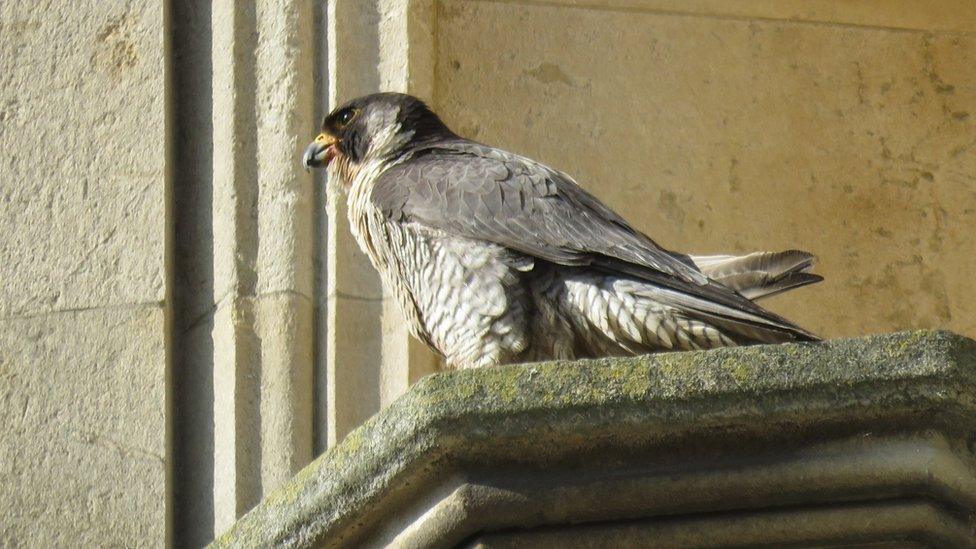
The family of six peregrines are being monitored and photographed by a dedicated team of volunteers on the ground

'This pair are amazing parents'
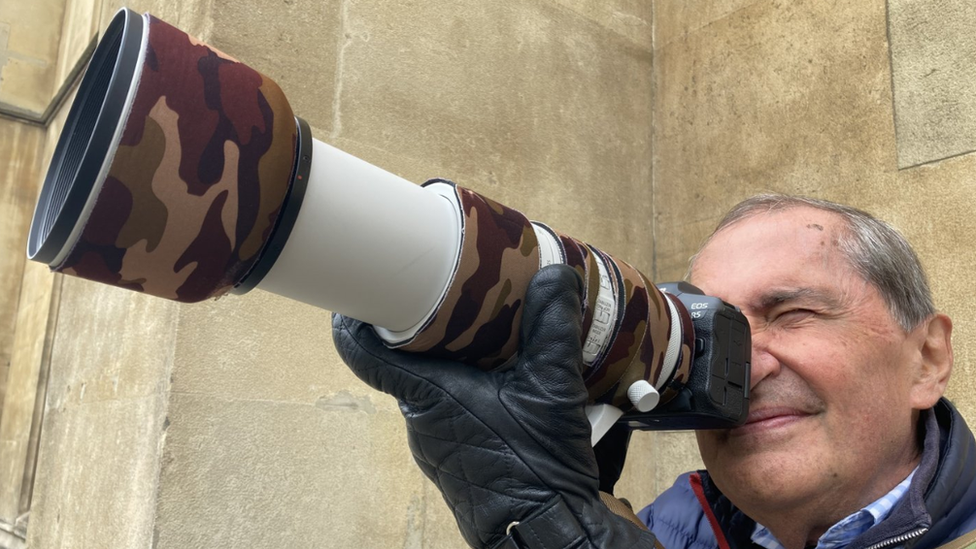
Andrew Bryce says the peregrine falcons are "very charismatic" and "very efficient killers"
Retired solicitor Andrew Bryce has been taking the short walk from home to this spot for the last four years.
"When I was younger you didn't see a peregrine because their numbers were tiny as a result of post-war use of pesticides, so if you saw one it was a real event," the 75-year-old says.
"Now they're in all the cathedral cities.
"As a birder I like to see the behaviour - it's unpredictable. But it's all about the birds, increasing the likelihood of survival.
"We try to be here most of the time during the breeding season so we communicate to make sure someone is here to look out for them.
"A lot of people come by and it's nice to educate people while we're doing it.
"It's a very hazardous environment, with the traffic and the people. We had one fall in the road here during a Bank Holiday, it just literally dropped in the middle of the road.
"We had to stop the traffic - it's a real carnival when that happens."

The photographers, some of whom are trained to handle the birds, rescued a chick that had fallen in the road
"They are very charismatic birds, very efficient killers - and this pair are amazing parents.
"There's a big aesthetic involved with peregrines. To see them flying at height and at speed is pretty impressive, it's a bit of a kick really."

'Speed, looks... and glamour'
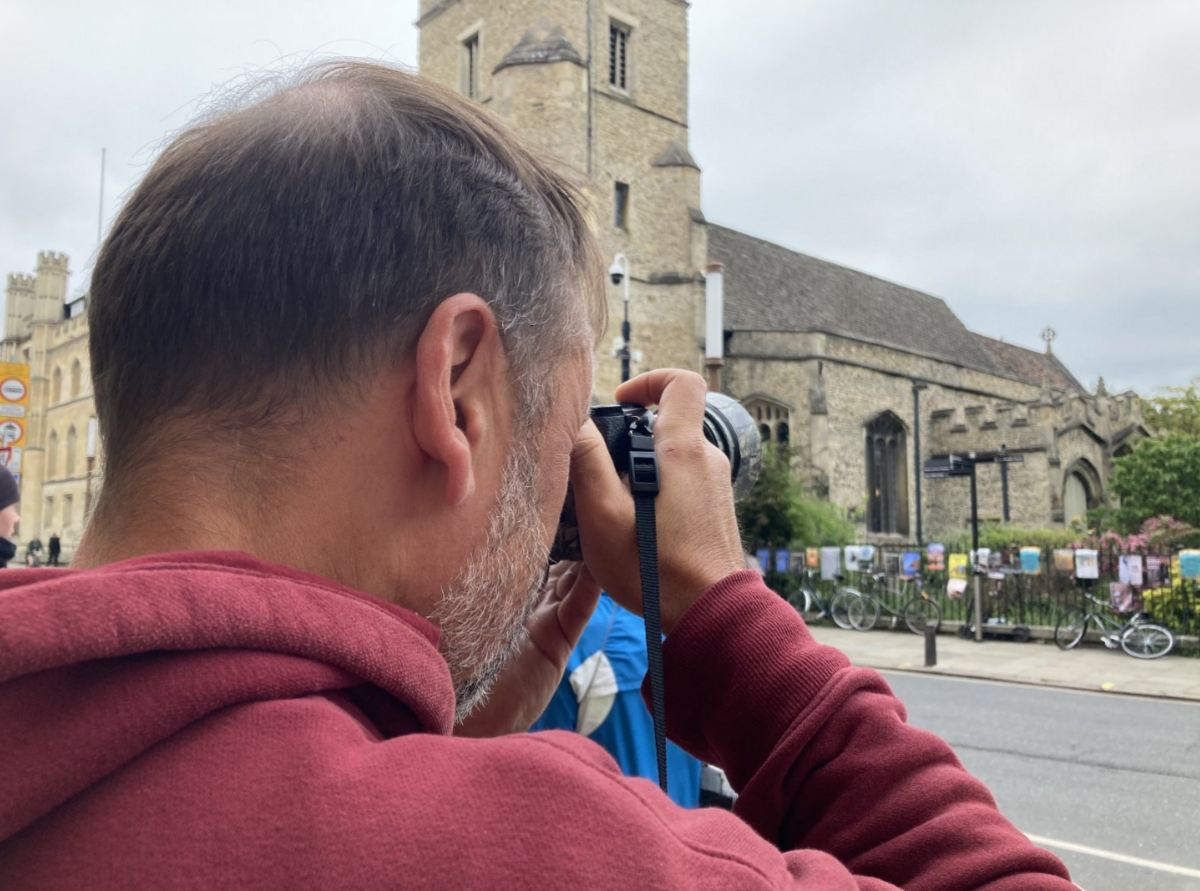
Paul Halliwell is a falconer so his expertise in handling the birds has been essential
"I've had a genuine obsession with these birds for thirty or forty years, it's a very symbiotic thing," falconer Paul Halliwell says.
"The birds give so many people so much pleasure. People benefit and the birds benefit and the whole town benefits."
Mr Halliwell uses his camera like binoculars, monitoring the new chicks as they find their wings around the tall buildings of Cambridge.
"I'm here to make sure the birds are fine but I get a lot from it as well," he says.
"When I was a kid these were genuinely rare birds. I would have to travel to Cornwall or Scotland to see them.
"It's speed, looks, glamour, they're very enigmatic. They're wild animals so they have an air of aloofness and remoteness that I don't think you get with any other animal.
"With the internet generation there's so much more awareness - but there's a disconnect and it's very well watching something on the TV or in a classroom or a cellphone but to stand in the street and see something 25 metres away going on in front of you - this is a human experience."

Find BBC News: East of England on Facebook, external and Instagram, external. If you have a story suggestion email eastofenglandnews@bbc.co.uk or get in touch via WhatsApp on 0800 169 1830
Related topics
- Published6 June 2023
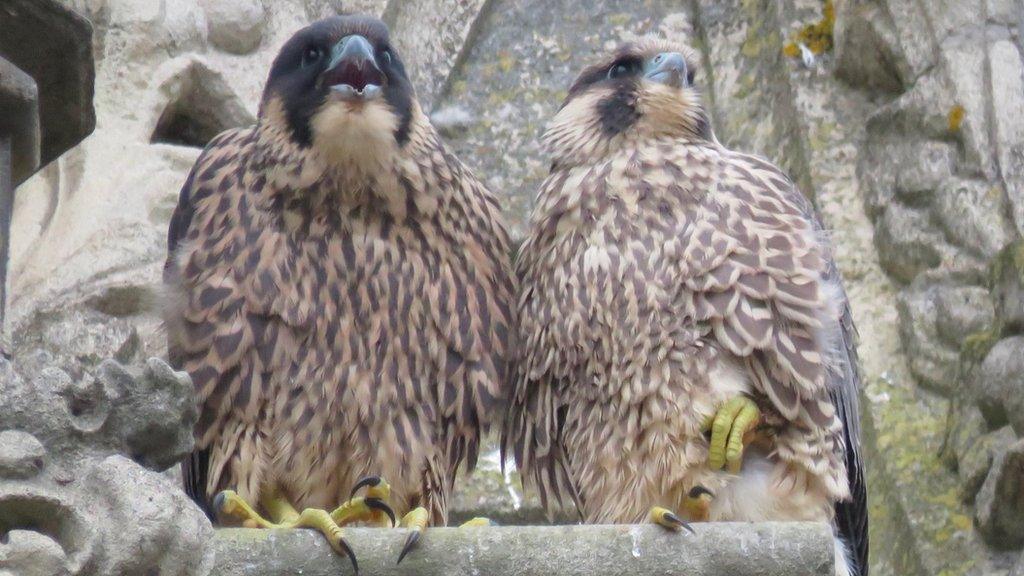
- Published19 May 2023
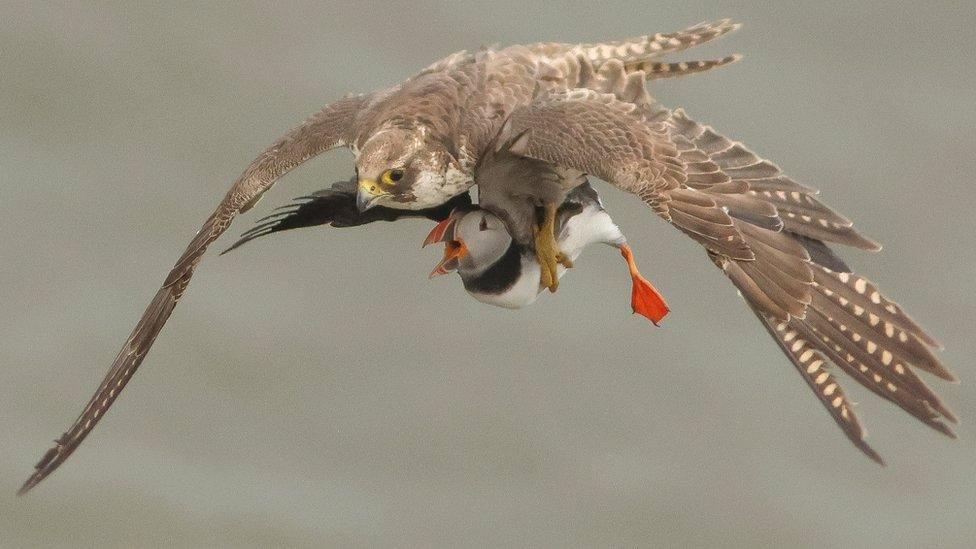
- Published5 April 2023

- Published21 April 2023
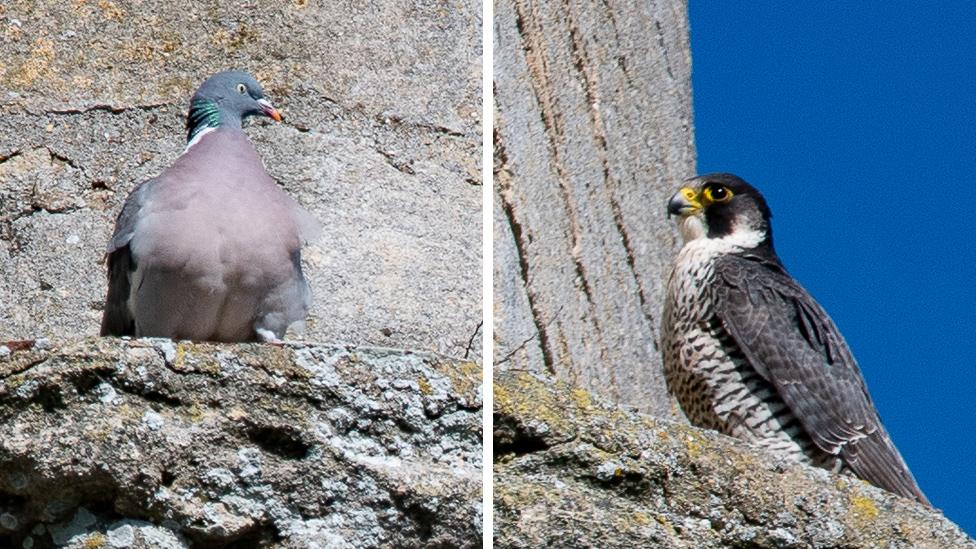
- Published3 June 2021
